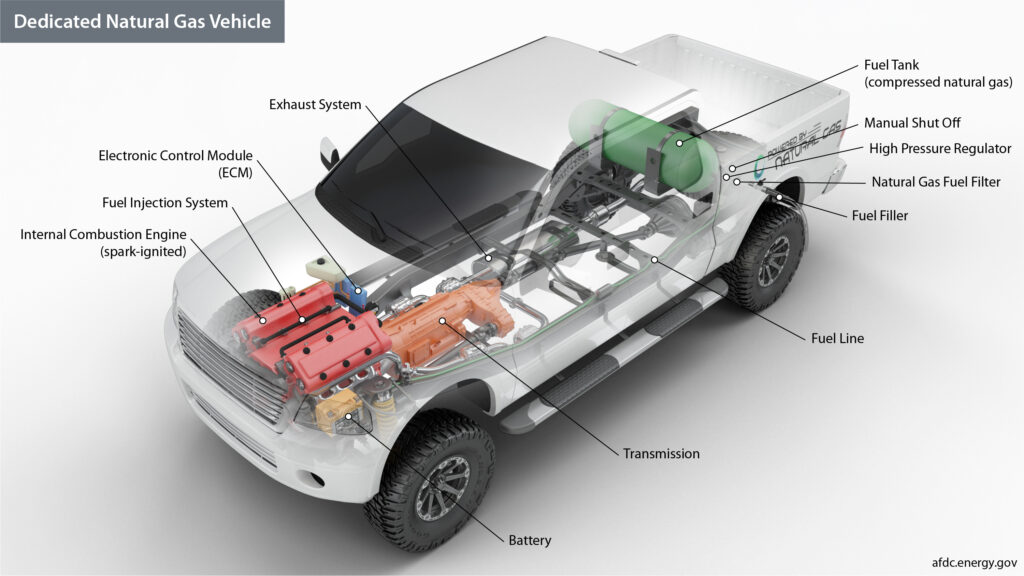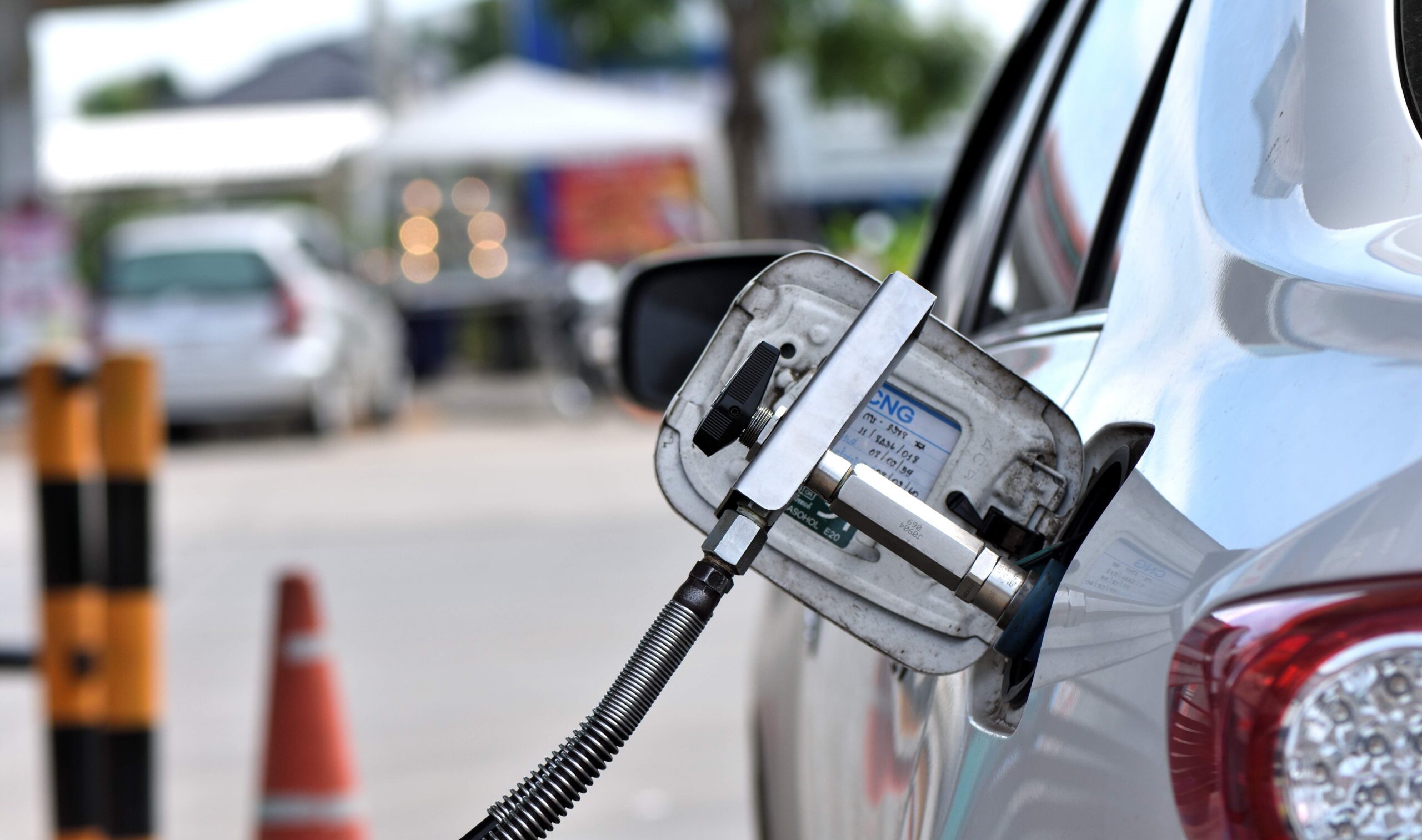Natural gas vehicles (NGVs) are vehicles that can be used as a substitute for conventional petrol and diesel-powered vehicles. These vehicles don’t run on auto gas (Liquified Petroleum Gas), instead, they use fuel in a gas form, that is either compressed natural gas (CNG) or liquified natural gas (LNG). The first natural gas vehicles were produced in the 1930s in the United States.
These vehicles were first used as war vehicles during WWII in Europe, they became widely popular in the early 1950s.
How do Natural Gas Vehicles work?
Vehicles fueled by natural gas are a viable alternative to petrol for light-duty applications. CNG fuel systems have a pressure reduction device between the storage tank and the engine to bring the natural gas’s pressure down to the level the fuel injection system needs. Injecting natural gas into an engine causes the compression of the fuel-air combination, which is then ignited by a spark plug. The vehicle is propelled by expanding gases.
Although spark-ignited natural gas systems are commonly used in heavy-duty vehicles, alternative systems are also available. Compression-ignition (diesel) cycles are used to burn natural gas in high-pressure direct injection engines. Furthermore, diesel engines may frequently be retrofitted to run on a combination of diesel and natural gas.
Types of Natural Gas Vehicles
They are three types of Natural Gas Vehicles Namely:
• Dedicated: Exclusively using natural gas, these vehicles are “dedicated.”
• Bi-fuel: Light and medium-duty vehicles that can switch between natural gas and petrol are called “bi-fuel.”
• Dual fuel: Heavy-duty applications that run on a combination of natural gas and diesel.
Why CNG Vehicles are Replacing Diesel and Petrol-Powered Vehicles
When compared to diesel and petrol, CNG has far less environmental impact. This means it produces negligible amounts of carbon and other greenhouse gases. The system can cut CO2 output by as much as 97%. The amount of pollutants released into the atmosphere is drastically cut down. This means it has a very low impact on the environment.
Compared to petrol and diesel, CNG’s cheaper cost makes it a more affordable option for the general public. Also, it does its job well and is simple to use.
Recommended Post: Innoson Unveils Gas-Powered Cars as Alternative to Fuel and Diesel
Key Component of Natural Gas Vehicles

Natural Gas Fuel Filter: The fuel filter for natural gas collects debris and other impurities to keep them from reaching the injectors and other vital parts of the fuel system.
Exhaust system: The tailpipe is the exit point for the exhaust gases produced by the engine. Emissions from the engine may be cut down with the use of a three-way catalyst in the exhaust system.
Manual Shut off: The gasoline supply may be cut off manually if the driver or mechanic has to.
Battery: Starts the engine and powers electronics/accessories.
Fuel filler: To fill the tank, just connect the gasoline dispenser’s nozzle to the corresponding port on the vehicle.
Fuel Line: receives fuel from the tank through a fuel line, which can be either a rigid metal tube or a more flexible hose.
Transmission: converts mechanical energy produced by the engine or electric traction motor into motion for the wheels.
Electronic control module (ECM): The ECM is an electronic component that regulates the engine’s fuel/air ratio, combustion timing, and emissions system, monitors vehicle performance, protects the engine from misuse, and identifies and diagnoses malfunctions.
Fuel Tank: Holds a supply of CNG until it’s needed by the engine, then releases it.
Internal Combustion Engine (spark ignited): The air/fuel mixture of a spark-ignited internal combustion engine is combusted after being fed into the intake manifold or the combustion chamber and then sparked by a spark from a spark plug.
Fuel Injection System: The fuel for an internal combustion engine is injected directly into the combustion chambers, where it is ignited.
High-Pressure Regulator: The function of the fuel system’s high-pressure regulator is to bring the gasoline’s pressure down to a safe level before it enters the engine’s fuel injection system.
5 Other Uses of Compressed Natural Gas (CNG)
1. Chemicals, fertilizers, and hydrogen require natural gas as an integral input.
2. CNG is used for water heating and it’s the best alternative for residential use.
3. It is used as a cooking fuel
4. CNG is used for transportation
5. CNG is used for generating electricity
Advantages of CNG Vehicles
1. Often CNG vehicles are more affordable than petrol or diesel. Although the price of compressed natural gas (CNG) may differ based on where you live and how much of it is available.
2. They mitigate changes in oil prices internationally because they are generated locally and increase energy independence and lessen dependency on foreign oil.
3. Due to CNG’s cleaner combustion, engines may last longer and have less wear and tear than when running on other fuels. The reason for this is that CNG causes less carbon buildup in engines than other fuels do.
4. Compressed natural gas (CNG) is an emission-friendly fuel that may be used with minimal damage to the environment. In comparison to other fuels, its combustion results in dramatically reduced emissions of Carbon monoxide (CO), Nitrogen oxide (NO), and Particular Matter (PM).
5. Noise levels are reduced by 30% than in alternative fuel engines.
Disadvantages of CNG
1. CNG car requires a higher level of concentration, lack of maintenance can lead to severe engine damage.
2. There is a limited number of petrol stations for CNG vehicles thereby making fueling difficult.
3. Vehicles driven by compressed natural gas (CNG) are less technologically sophisticated than their gasoline-powered counterparts, according to CNG car owners.
4. CNG engines degrade more rapidly than those gasoline-powered ones.
5. CNG cars’ short driving distance is a significant drawback. Due to the decreased energy density of CNG compared to petrol, a CNG-powered vehicle may require refuelling more frequently.
5 Benefits of CNG Vehicles
1. Compressed natural gas (CNG) blends in with the air quite well due to its gaseous state.
2. They are economical (easy to manage) and have better mileage.
3. CNG do not contain lead nor benzene and does not contribute to air pollution and will not cause spark plugs to corrode. CNG also lowers hazardous emissions, which in turn mitigates the impact of global warming, earning it the nickname “green fuel” because of its lack of lead and Sulphur.
4. Unlike other fuels, compressed natural gas has a relatively small flammability window. Natural gas (CNG) has a greater ignition temperature than other fuels, making it less likely to ignite on its own.
5. CNG are Toxin-free, corrosion-free, and cancer-free which are beneficial to public health.
Example of Vehicles that uses CNG
Transit buses
School Buses
Heavy-Duty Vehicles
Refuse Trucks
Concrete Mixers
Semi tractors
Passenger Cars
Rocket cars
Aeroplanes
Helicopter
Vans













